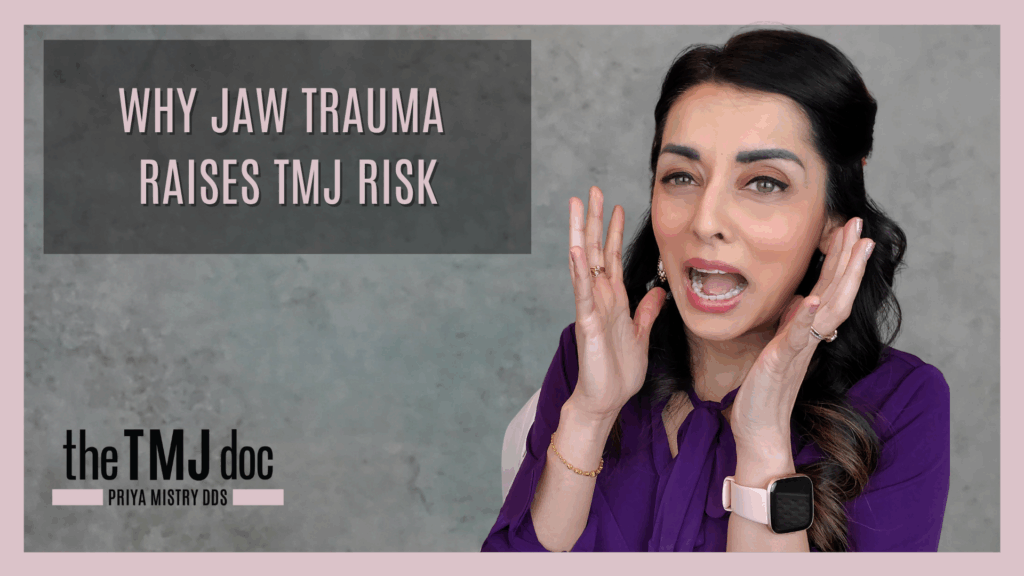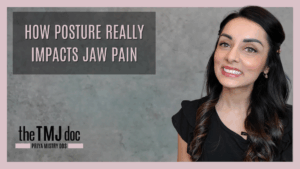Many patients with TMJ pain or dysfunction don’t realize a past injury may be to blame. Trauma to the face, head, or neck can change how the joints, muscles, nerves, and bones respond. Dr. Priya Mistry frequently uncovers stories of small knocks or accidents that later become chronic jaw pain. Understanding these connections helps guide better treatment.
Here’s how trauma impacts TMJ health and what to watch for going forward.
How Trauma Can Destabilize the Jaw
Blunt Force & Direct Impact
A blow to the jaw from a fall, sports collision, or car accident can strain ligaments, displace joint components, or injure cartilage. Even if the initial pain seemed to resolve, microdamage can evolve into a dysfunctional joint over time.
Whiplash & Neck Injury
In a whiplash event, the head snaps forward and back. That force propagates to the jaw, shifting alignment and stressing the TMJ apparatus. Because the jaw and neck are biomechanically linked, neck injury frequently contributes to TMJ problems down the road.
Dental Work & Oral Procedures
Extractions, orthodontic adjustments, or implants can alter how the bite loads the joint. If not delicately handled, sudden bite shifts or surgical trauma may trigger TMJ issues post-procedure.
Cumulative Microtrauma
It’s not always a dramatic event. Repetitive microtrauma, chewing on hard objects, clenching during stress, or nighttime grinding adds up and can worsen a vulnerable joint. A seemingly minor injury becomes the straw that breaks the camel’s back.
Symptoms That May Point to a Traumatic Origin
If you’ve had a facial or neck injury, even years ago, be alert for these TMJ-related signals:
- Welcome or worsening jaw pain with side-to-side movement
- Changes in bite or “off” feeling when you close
- Repeated jaw locking or catching
- New onset clicking or popping
- Muscle spasms in the face, neck or shoulders
- Headaches or ear fullness tied to jaw movement
These symptoms may not show immediately after injury but gradually emerge as compensations build.
What The TMJ Doc Would Do Differently
Dr. Priya Mistry’s approach blends symptom relief with digging out the root cause, especially when trauma is involved.
- Full history & trauma review
Every patient’s medical, dental, and injury history is explored. Even seemingly unrelated accidents can matter. - Comprehensive exam & imaging
We assess joint motion, muscle balance, cervical mobility, and if needed order imaging (CBCT, MRI) to spot structural changes from prior trauma. - Stabilization first
Before asking healing tissues to adapt, we may provide a precision oral appliance that supports the joint, absorbs load, and helps muscles reset. - Phase-based plan
Treatment might include cranial/NVC therapies, controlled bite alignment (e.g., DTR), posture & bodywork referrals, airway optimization, and neuromuscular re-education. - Monitoring & adaptation
Because trauma-generated issues can evolve, regular follow-up is critical. We adjust treatment as the system adapts and tissue remodeling occurs.
How You Can Help Your Recovery
Trauma-induced TMJ stress takes time to heal, and patients play an active role:
- Rest the joint: minimize chewing hard foods, avoid wide yawns
- Gentle mobility: low-load jaw movements (within comfort)
- Posture care: as with all TMJ protocols, head/neck alignment matters
- Breathing & stress management: keep sympathetic tension low
- Inform providers: dentists, chiropractors, PTs- make them aware of your jaw history
Healing a traumatized joint is less about forcing change and more about supporting a return to balance over time.
Time to Partner with The TMJ Doc?
If you’ve had a facial, neck, or head injury, even in the distant past, and are now dealing with jaw pain, restrictions, or clicking, it may be time for an evaluation tailored to your specific history and anatomy.
Dr. Priya Mistry offers a comprehensive, trauma-aware approach that respects your body’s timeline and aims for sustainable relief.
You don’t have to live with a painful jaw. Let’s work together to heal it.






